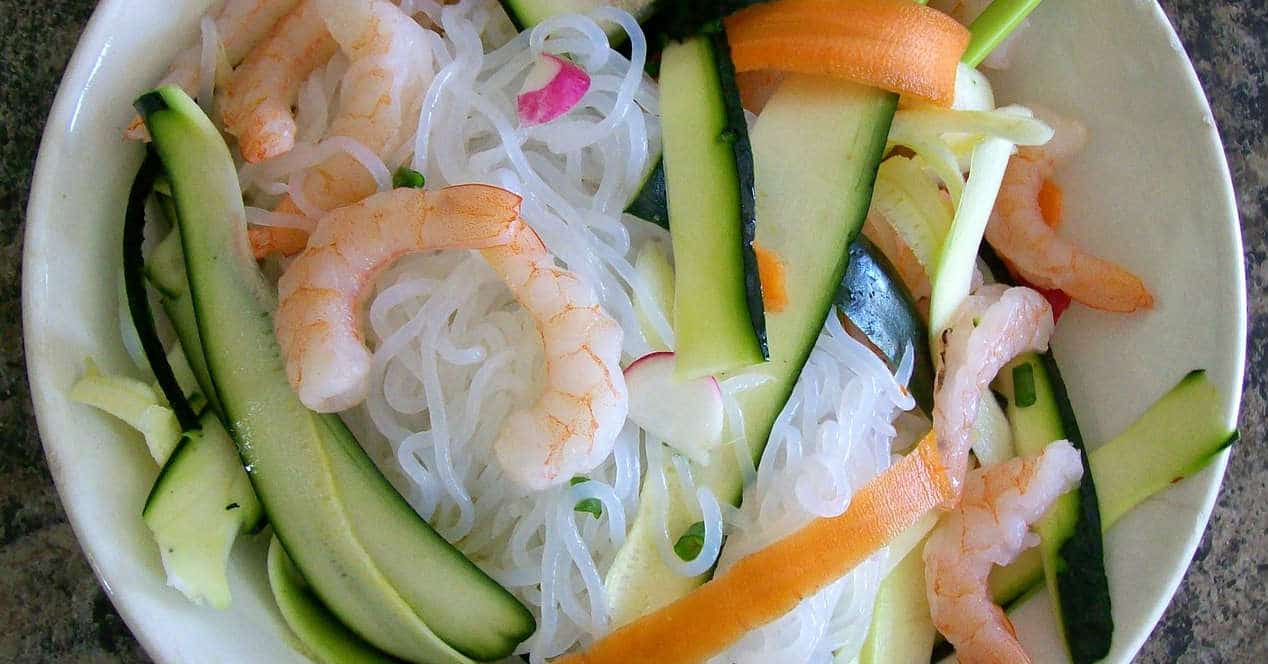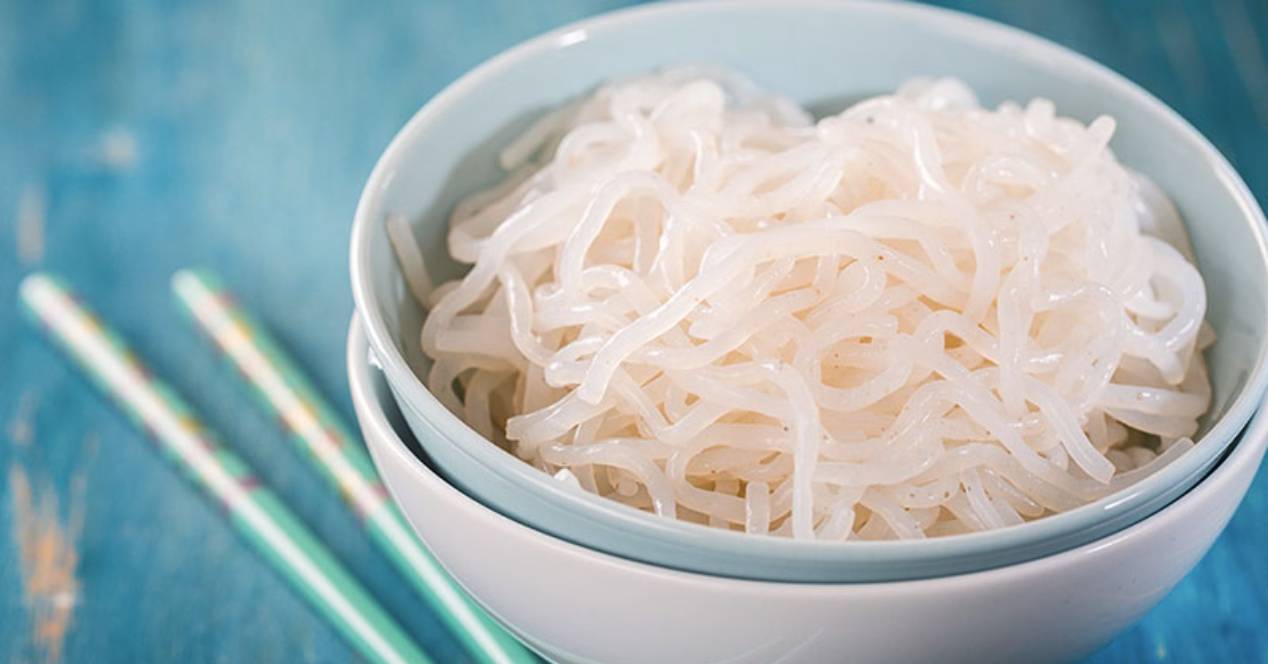
Most of the new trends tend to come to us from Asian countries, where food is very different from Western food. Taking this into account, we should also know that this has caused them to have a higher tolerance for certain foods that we do not have. One of them is konjac.
The latest fashionable food is called Konjac and, although its name reminds you of an alcoholic drink, the reality is that it is a tuber full of beneficial properties. We tell you what it is and if it really is a dietary food, ideal for losing weight and having a healthy life.
What is it?
The konjac (actually called Amorphophallus konjac) is a tuber of Asian origin and widely consumed in China, Japan and Korea. What we consume is the konjac root, as it happens with the potato, and they assure that it is made up of 100% fiber and with a great capacity of water absorption.
Maybe the name sounds familiar to some glucomannan, and it is that the Konjac fiber has been used under this name in pastas and dietary products that ensure weight loss. In fact, it is increasingly common to find Konjac noodles in supermarkets.
It is curious that the paste of this tuber has become so fashionable when, really, it provides almost no nutrients. More than 90% of its content is water, so we should not make the mistake of replacing our usual intake of cereals or whole wheat pasta with this type of noodles.
Curiously, this is the reason why many people use it in their weight loss diets. I do not want to say that we cannot include it in a varied and balanced diet, but that it should not become a substitute for anything.
Cooking the noodles is as easy as putting them to cook for a couple of minutes. It is true that its gelatinous texture and insipid flavor can make them unattractive, but seasoning it with the right spices and combining it with vegetables and proteins, we will have a tasty dish. And nutritious!
As benefits we can highlight its satiating effect for a longer time, thanks to the large amount of fiber it provides us. In addition, they ensure that it controls cholesterol levels, reduces constipation, maintains blood sugar levels and improves the appearance of the skin. In case you didn't know, Konjac is also used in the cosmetics industry, although not in the form of noodles.

Nutritional Information
These whole tubers are mostly carbohydrates and contain virtually no fat. According to a March 2016 study in Food Reviews International magazine, it is made up of:
- 54 to 7% fiber (of which 61 to 6% is glucomannan fiber)
- 12 to 3% starch
- 2 to 7% sugar
- 5 to 7% protein
Whole konjac also contains small amounts of a variety of micronutrients, which include vitamin A, vitamin B1 (thiamine), vitamin B2 (niacin), vitamin B3 (riboflavin), calcium, copper, iron, magnesium, manganese, phosphorus, selenium, and zinc.
Once processed, konjac can be used as a starch, flour, or gel. The flour, which is primarily glucomannan fiber, can be used to make low-carb variations of noodles or rice. However, very little is required to make these types of products. Most konjac products are mostly water, with small amounts (between 1 and 5%) of konjac.
The average product is essentially just fiber and no other nutrients. For example, the famous konjac spaghetti, for each 100-gram portion, we find 9 calories, 4 grams of fiber and 0 grams of protein. There are no other nutrients.
You'll find similar nutrition for most prepackaged products. Organic rice has 10 calories, 5 grams of fiber and 0.3 grams of protein, in a 128-gram serving. The label for this product also says that it also contains small amounts, between 1 and 4 percent of the daily value, of calcium and phosphorus.
Services
Most Spaniards consume only 15 grams of fiber per day, approximately half of the total amount they should consume. Integrating konjac into your diet can help increase that fiber intake and improve health.
However, it also has some benefits associated with its specific type of soluble fiber, glucomannan. According to a May 2016 study in the Journal of Food Hydrocolloids, glucomannan can:
- Supports weight loss.
- It stimulates the microbes that live in your colon.
- Stimulates the immune system. Thanks to the antibacterial and antioxidant properties of the konjac plant, it is believed that we can obtain greater immunity. The body can help fight common illnesses like colds and flu more effectively.
- Regulates cholesterol levels.
- Reduces triglycerides.
- Promotes feelings of fulfillment.
- Provides the intestine with beneficial prebiotics.
- Control of diverticulitis.
- Helps control diabetes. As konjac contains glucomannan, this is a great agent to help control sugar levels in the body, therefore helping with diabetes control and symptoms.
- Helps control irritable bowel disease.
- Relieves constipation.
- They attach to pathogens and prevent disease.
- It is anti-inflammatory. It contains large amounts of anti-inflammatory agents, which can help with bone and joint health. We can find a way to properly nourish the bones and decrease joint pain. This is especially helpful for those who suffer from conditions like arthritis.
It can also be an alternative for those people on low carb or ketogenic diets. Because they have zero net carbs, foods made with konjac are ideal, and they're low in calories.

Does it promote weight loss?
While it appears that konjac root may offer some help with weight loss, reports are inconsistent. Glucomannan helped a small group of obese participants lose more weight and fat than a group taking a placebo, according to a 2015 study published in the Journal of the American College of Nutrition. However, another study, published in 2014 in the same journal, reported conflicting results, noting that the weight-loss supplement did not help people lose more weight than a placebo group.
Compliance taking the supplement may need to be taken into account when evaluating the results of these two apparently conflicting studies. The 2015 study reported significant weight loss once noncompliant participants were removed from the results. But more research with accurate reporting from participants is still needed to determine if konjac root can reliably help with weight loss.
As a supplement, it is not certain if the root is an effective weight loss tool, but it is used to prepare foods low in calories that could help you save calories in your diet to lose weight. Shirataki noodles, spaghetti-like noodles made from konjac root, are not only low in calories, but also low in carbohydrates. A 114-ounce serving has 10 calories, 3 grams of carbohydrates, and 3 grams of fiber. Like tofu, shirataki noodles take on the flavor of whatever they're mixed with, so mix these low-calorie noodles with your favorite tomato sauce or use them to make a noodle stir-fry.
Konjac root is also used to make "rice," a calorie- and carbohydrate-free product, making it a good substitute for real rice, which has 250 calories in a cooked 1-cup serving. Serve as a side dish or use it to make a grain-based salad.
What products contain konjac?
Konjac is a staple in Japanese cuisine, but it can also be found in non-food products.
- Foods: konjac is an ingredient in various food products, including shirataki noodles, gelatin, and konjac flour. These ingredients are popular in traditional Japanese cooking; some producers also market them as gluten-free replacements.
- Dietary supplements: we can buy glucomannan, an important component of konjac, as a dietary supplement. However, the FDA does not regulate supplements, so there is no standard dosage. We will consult a health professional before adding supplements to the diet.
- Skin care: Konjac root is a popular cleansing tool in the skin care industry. We can use a konjac sponge (made from the root) to gently cleanse and exfoliate the skin, removing dead skin cells. To apply, we will simply immerse the sponge in warm water for ten minutes. We will apply the wet sponge directly to the face, massaging the sponge in circular movements to completely cleanse the skin.
Possible risks
The side effects come from the type of carbohydrates it contains. Although these are generally beneficial, they are not right for everyone.
As a prebiotic, konjac contains fermentable short-chain carbohydrates (also known as FODMAP or fermentable oligosaccharides, disaccharides, monosaccharides and polyols). The fermentable carbohydrate content is usually good for your health, but it can also be difficult for certain people to digest. When we eat them, these carbohydrates ferment in your large intestine, where they can cause a variety of gastrointestinal side effects.
Foods high in FODMAPs can cause gastrointestinal problems, such as bloating, gas, cramps, and stomach aches. Certain people, such as those with irritable bowel syndrome, may need to avoid foods high in FODMAPs. If you have experienced unpleasant intestinal problems after eating konjac, you may need to limit your intake of fermentable carbohydrates or simply consume less of them.
However, as with all fiber-rich foods, it should be eaten in moderation. If you're trying to increase your intake of dietary fiber, you shouldn't do it all at once or you're more likely to experience side effects. Consuming too much fiber can lead to a variety of intestinal problems, including cramps, diarrhea, and even constipation.
When taken as a dietary supplement for a short period of time, up to 16 weeks, konjac root appears to be safe. However, side effects have been reported, including abdominal pain, diarrhea, gas, and constipation.
If you have trouble swallowing, for example due to esophageal strictures or narrowing, you may want to stay away from konjac tablets. The supplement can expand in the esophagus on its way to the stomach and cause a blockage. However, the same effects have not been observed in konjac powder or in supplement capsules.
excess fiber
According to Harvard Health Publishing, women should consume between 21 and 25 grams of fiber per day, while men should consume between 25 and 30 grams of fiber per day. The exact amount you should consume is based on your total calorie intake.
There are two types of fiber you can eat: insoluble fiber and soluble fiber. You should get about 60% of your daily fiber intake from insoluble fiber, which supports the digestion and excretion of food as it passes through your GI tract. This type of fiber is not broken down during the digestion process.
The remaining 40% of your fiber intake should come from soluble fiber, such as glucomannan. The soluble can help regulate blood sugar and cholesterol and delay digestion. Unlike the insoluble, it breaks down when it is digested, specifically during the digestion process; and can help regulate blood sugar and cholesterol. Insoluble fiber is not broken down: This type of fiber aids in the digestion of other foods as it moves through the intestine.
Since the main nutrient you'll find in konjac is glucomannan, the main benefit it has is its soluble fiber content.